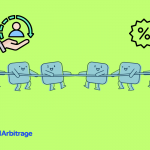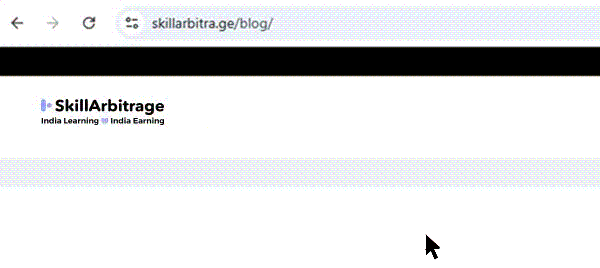This blog offers an in-depth guide to creating cluster-based content—an essential approach for helping any piece of content rank higher in search results. It’s a valuable resource for content writers, copywriters, and marketing professionals who want a proven, failsafe strategy to boost their content’s visibility.
Table of Contents
Introduction
“I am writing decent blog posts, but why are they not ranking?” my friend was sad and contemplative.
We had met for coffee after a long week, and the troubles of the week had not all washed off. She was upset that the blogs she poured hours into did not come to much.
This wasn’t her problem alone. Most content writers face the same problem: they pour their heart and soul into a piece of writing, a blog, or a LinkedIn post, and are dumbstruck when none of it sticks or ranks.
What most of us don’t know is that content creation is not a straight line; it is instead a web-like structure, an entire content plan with strategic pieces linking back to each other.
If you are like most content writers, you have probably felt that frustrating moment when you publish what you think is amazing content, only to watch it disappear into the Google void.
Sound familiar? You’re not alone, and more importantly, you’re not doing anything fundamentally wrong.
The problem isn’t your writing, it’s your strategy.
Here’s the thing: isolated blog posts scatter your authority across the web like confetti in the wind. While you might rank for a few long-tail keywords here and there, you’re missing out on the bigger picture.
Google doesn’t just want to see that you can write about a topic once; it wants to see that you’re a genuine authority who understands a subject inside and out, before letting the answer seekers find your piece.
With Google’s emphasis on E-E-A-T (Experience, Expertise, Authoritativeness, and Trustworthiness), search engines are prioritizing websites that demonstrate comprehensive knowledge across related topics rather than one-off posts that barely scratch the surface.
The solution?
Cluster-based content planning. Cluster-based content planning is a strategic approach that organizes your content into interconnected topic clusters that signal to Google that you know what you’re talking about.
You know the best part?
In this era of AI, you can plan and implement these clusters faster than ever before.
In this guide, I am going to walk you through an AI-driven process that will help you create content clusters that boost your topical authority, enhance your internal linking strategy, and accelerate your SEO rankings.
Everything you need to know about content clusters
Before I tell you about the AI tools, let’s make sure we are on the same page about what content clusters actually are and why they are so powerful.
Think of a content cluster as a family of related articles with one main “parent” piece (called pillar content) surrounded by several “children” pieces (supporting subtopics). The pillar content covers a broad topic comprehensively, while the supporting pieces dive deep into specific aspects of that main topic.
Here’s how it works in practice:
Let’s say your pillar topic is “Sustainable Fashion.” Your supporting subtopics might include pieces on eco-friendly fabrics, ethical fashion brands, upcycling techniques, sustainable fashion trends, and the environmental impact of fast fashion.
Each of these subtopics links back to your main pillar page and connects to each other through strategic internal linking.
This approach signals to Google that you have comprehensive coverage of sustainable fashion.
You are not just someone who wrote one article about it; you are someone who truly understands the entire ecosystem around this topic.
The benefits go beyond just SEO rankings.
Content clusters enhance your site’s crawlability, making it easier for search engines to understand your content structure. They create stronger internal linking opportunities, which help distribute page authority across your site.
Most importantly, they help you build genuine expertise and authority in your niche, which translates to better E-E-A-T signals.
Compare this to the random blogging approach most writers take. Like my friend or like me.
Publishing whatever feels interesting or trending at the moment might occasionally hit the mark by some random chance.
.Cluster-based planning, on the other hand, is like building a strategic web of knowledge that grows stronger with each piece you publish.
The difference in results can be dramatic.
Where random blog posts might struggle to rank beyond page 3 or 4 of Google, well-planned content clusters often see their pillar content ranking on page 1 within months, with supporting content following close behind.
How to use AI for cluster planning
Now, you might be thinking, “This sounds great in theory, but planning content clusters seems like a massive undertaking.”
And honestly?
You are right. Traditional cluster planning is incredibly time-consuming and research-heavy.
What does manual cluster planning look like?
Backbreaking hours of keyword research, competitor analysis, topic brainstorming, search intent investigation, and content gap analysis.
By the time you’ve mapped out one solid cluster, you could have written three blog posts. It’s no wonder most writers skip this step and just wing it.
This is where AI becomes your secret weapon. AI tools can compress weeks of research and planning into hours or even minutes.
They excel at pattern recognition, making them perfect for identifying related topics, clustering keywords semantically, and predicting search intent across multiple subtopics.
How is AI a complete game-changer?
It provides lightning-fast topic ideation that considers search volume and competition, and automatic keyword clustering that groups related terms more accurately than manual methods. It is also extremely good at search intent prediction, which helps you match your content to what users want.
You don’t need expensive tools to get started, either.
Free options like ChatGPT and Google Gemini can handle most of your cluster planning needs with the right prompts.
If you want to level up, paid tools like Surfer SEO, Frase, and Keyword Insights offer more sophisticated clustering and keyword data, but they’re not essential when you’re starting out.
Let me give you a quick example of AI in action. I recently asked ChatGPT to generate subtopics for “mental wellness,” and within seconds, I had a comprehensive list including stress management techniques, mindfulness practices, work-life balance strategies, nutrition for mental health, exercise and mental wellness, and sleep hygiene.
Each suggestion came with content type recommendations and target audience insights. What would have taken me hours of research happened in under a minute.
The key is knowing how to prompt AI effectively, which is exactly what we’re going to cover in the next section.
Step-by-step guide to building a topic cluster
Ready to build your first AI-powered content cluster?
Let’s break it down into manageable steps that you can implement immediately.
Step 1: Choose your pillar topic
Your pillar topic is the foundation of your entire cluster, so choosing the right one is crucial.
You want something broad enough to support 5-8 subtopics but specific enough to be manageable for your expertise level.
Here’s my go-to AI prompt for pillar topic research: “Suggest 5 pillar topics for [your niche] with high search volume and medium competition. Include estimated difficulty and content depth required for each.”
For example, if you’re in the digital marketing space, you might get suggestions like “Digital marketing for small businesses,” “Content marketing strategy,” “Social media advertising,” “Email marketing automation,” and “SEO for beginners.”
Don’t just take AI’s word for it, though.
Validate these suggestions using Google Trends to check for sustained interest over time and AnswerThePublic to see what real questions people are asking.
You want a topic that has staying power, not just a temporary spike in interest.
Let’s say you choose “Digital marketing for small businesses” as your pillar topic.
This works because it’s broad enough to cover multiple subtopics (social media, email marketing, SEO, content marketing, analytics) but specific enough that you can become a genuine authority on it.
Step 2: Generate your subtopics
Once you have your pillar topic, it’s time to identify the supporting subtopics that will make up your cluster.
This is where AI really shines, because it can quickly identify related topics and organize them by search intent and content type.
Try this prompt: “List 6 subtopics for ‘Digital marketing for small businesses’ with recommended content type and search intent for each. Organize by informational, commercial, and transactional intent.”
You might get results like:
- Social media advertising for small businesses (How-to guide, Commercial intent)
- Email marketing tips for local businesses (List post, Informational intent)
- Small business SEO checklist (Checklist, Informational intent)
- Budget-friendly marketing tools (Comparison post, Commercial intent)
- Content marketing strategy for small teams (Strategy guide, Informational intent)
- How to measure digital marketing ROI (Tutorial, Informational intent)
The beauty of this approach is that AI automatically considers search intent, which is crucial for creating content that actually satisfies user needs.
You are not just creating content for the sake of it, you’re solving specific problems at different stages of the customer journey.
Step 3: Cluster your keywords
Now comes the technical part that used to require expensive SEO tools, keyword clustering.
AI can group related keywords semantically, helping you optimize each piece of content for multiple related terms without keyword stuffing.
Use this prompt: “Group these 20 keywords for ‘digital marketing for small businesses’ into 5 semantic clusters: [insert your keyword list]. Include primary and secondary keywords for each cluster.”
If you don’t have a keyword list yet, ask AI to generate one first: “Generate 20 high-value keywords related to ‘digital marketing for small businesses’ with search volume estimates.”
The AI might cluster your keywords like this:
This clustering approach ensures each of your subtopic pieces targets a group of related keywords naturally.
A much better approach than trying to force unrelated terms into a single post.
Step 4: Plan internal linking structure
Internal linking is where content clusters shine, but it can be tricky to plan manually. AI can help you create a linking strategy that maximizes the flow of authority throughout your cluster.
Try this prompt: “Suggest an internal linking structure for 1 pillar page about ‘digital marketing for small businesses’ and 5 supporting subtopics. Include anchor text suggestions and linking rationale.”
The general rule is that all subtopics should link back to the pillar page, and they should also link laterally to related subtopics where it makes sense.
For example, your email marketing post might link to the social media advertising post when discussing integrated campaigns, and both should link back to the main digital marketing pillar page.
AI can suggest specific anchor text variations to avoid over-optimization while maintaining relevance. Instead of always using “digital marketing for small businesses,” you might use variations like “comprehensive marketing strategy,” “small business marketing,” or “digital marketing approach.”
Step 5: Create your publishing calendar
Finally, you need a realistic timeline for publishing your cluster content.
AI can help you create a publishing schedule that balances SEO goals with your available time and resources.
Use this prompt: “Draft a 6-week publishing schedule for 1 pillar page and 5 subtopics about digital marketing for small businesses. Include estimated word counts and publishing order for maximum SEO impact.”
Here’s a flow chart for easier understanding:
AI might suggest starting with your pillar content to establish the foundation, then publishing subtopics in order of difficulty or seasonal relevance.
Free tools like ChatGPT are great for brainstorming subtopics and keywords, but paid tools like Surfer SEO offer advanced features like content scoring and SERP analysis for more precise optimization.
Consider using tools like Google Sheets, Trello, or Notion to track your progress and maintain your publishing schedule. The visual organization helps you see how your cluster is developing and identify any gaps or opportunities.
Mistakes to avoid
Even with AI assistance, there are several common mistakes that can undermine your content cluster strategy. Let me share the ones I see most often so you can avoid them.
First, resist the temptation to choose overly broad pillar topics.
“Marketing” is too broad; “Email marketing for e-commerce businesses” is much better. Broad topics lead to shallow content that tries to cover too much ground without providing real value.
Your pillar should be comprehensive but focused.
Ignoring search intent is another major pitfall. Just because keywords are related doesn’t mean they serve the same intent.
Someone searching for “email marketing tools” (commercial intent) has different needs than someone searching for “how email marketing works” (informational intent).
Make sure your subtopics align with the actual intent behind the searches.
Weak internal linking is perhaps the most common mistake I see.
Your cluster is only as strong as its connections. Don’t just add one token link from each subtopic back to the pillar; create a web of relevant, helpful connections throughout your cluster.
The linking should feel natural and add value for readers.
Over-relying on unedited AI outputs is tempting but dangerous.
AI provides excellent starting points and research assistance, but your expertise and editing are what make content truly valuable.
Always fact-check, add personal insights, and ensure the content matches your brand voice.
Finally, don’t neglect performance tracking. Without monitoring your results, you won’t know what’s working or how to improve. Set up proper analytics from day one and check in monthly to see how your cluster is performing.
Ready-to-use AI prompt bank
Here’s your toolkit of proven prompts that you can copy, paste, and customize for your own cluster planning:
Pillar Topic Research: “Suggest 5 pillar topics for [your niche] with high SEO potential and manageable competition. Include estimated content depth required and potential subtopic count for each.”
Subtopic Generation: “Generate 6 subtopics for ‘[your pillar topic]’ with recommended content type and search intent. Organize by informational, commercial, and transactional intent with estimated word counts.”
Keyword Clustering: “Group these 15 keywords for ‘[your pillar topic]’ into 4 semantic clusters. Include primary and secondary keywords for each cluster with search volume estimates: [insert keyword list]“
Internal Linking Strategy: “Suggest anchor text and linking opportunities for 1 pillar page about ‘[your topic]’ and 5 supporting subtopics. Include both contextual and navigational linking suggestions.”
Publishing Calendar: “Create a 6-week publishing schedule for 1 pillar page and 5 subtopics about ‘[your topic]’. Include optimal publishing order for SEO impact and estimated completion times.”
Content Gap Analysis: “Identify 3 content gaps for my ‘[pillar topic]’ cluster based on current industry trends, competitor analysis, and emerging search patterns.”
Remember to customize these prompts with your specific niche, audience, and goals. The more context you provide, the better AI can assist with your planning.
Here is what you will get when you use all of the prompts:
Conclusion
We’ve covered a lot of ground, but you will find new challenges when you start to work with the prompts I suggested.
The real trick is when you take these AI-driven cluster strategies and put them to work.
Strategic content planning isn’t just about better SEO rankings (though you’ll definitely see those).
It’s about positioning yourself as a genuine authority in your niche, creating content that actually helps your audience, and building a sustainable business around your expertise.
When you approach content with this level of intentionality, you’re not just another blogger hoping for luck; you are a strategic content creator with a clear path to success.
Here is your action plan to get started immediately:
Pick one pillar topic for your niche today. Don’t overthink it, choose something you’re genuinely knowledgeable about and passionate about exploring further.
Use the prompts in this guide to validate your choice and ensure it has solid search potential.
Build your first cluster using the AI prompts we’ve covered.
Start with subtopic generation, move through keyword clustering, and create your internal linking plan. This entire process should take you 2-3 hours max.
Publish your first subtopic within the next 7 days. Don’t wait until you have the entire cluster planned; start with one supporting piece and build momentum. The key is to begin, not to be perfect.
The content landscape is evolving rapidly, and AI is making sophisticated strategies accessible to individual writers and smaller teams. But remember: AI is your research assistant and idea generator, not your replacement.
Your expertise, insights, and unique perspective are what will make your content clusters truly valuable.
The question isn’t whether you should start using cluster-based content planning; it’s whether you’ll be ahead of the curve or playing catch-up.
The choice is yours, and the time to start is now.
FAQ
1: What is cluster-based content, and why is it important for SEO?
Answer:
Cluster-based content is a strategy where you create a central pillar page covering a broad topic comprehensively, then build multiple supporting articles that dive deeper into specific subtopics. All these articles link to the pillar page and to each other. This organized structure helps search engines understand your site’s authority on a subject, improving your chances of ranking higher for a wide range of related keywords.
2: How do I pick the right topics for my content clusters?
Answer:
Start by identifying your audience’s core problems and questions. Then research keywords to confirm search demand. Choose broad topics for pillar pages—like “Email Marketing”—and break them into related subtopics for cluster content—like “Email Segmentation,” “A/B Testing Emails,” and “Best Email Subject Lines.” The best clusters are those that align with both your audience’s needs and your business goals.
3: How many cluster articles do I need for each pillar page?
Answer:
There’s no strict rule, but most effective clusters include at least 5–10 supporting articles. The key is to cover the topic thoroughly enough that visitors (and search engines) see your site as the go-to resource. If your topic is complex, you may need even more supporting pieces to capture all the relevant subtopics.
4: How do I structure internal links in a content cluster?
Answer:
Every cluster article should link back to the pillar page with clear, descriptive anchor text. The pillar page should also link out to each cluster article. Additionally, you can interlink related cluster articles to help readers and search engines navigate the topic easily. This two-way linking structure strengthens topical relevance and improves crawlability.
5: How can I track the success of my content clusters?
Answer:
Monitor performance using metrics such as organic traffic, keyword rankings, time on page, bounce rate, and conversions. Tools like Google Analytics and Google Search Console will show how visitors find and engage with your content. If you see certain articles performing well, consider expanding those subtopics. If some pages underperform, update them with fresh information or improve their internal linking.







 Allow notifications
Allow notifications
